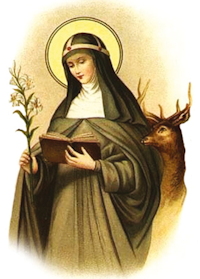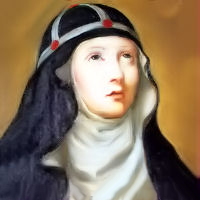Make your gift today!
Help keep Catholics around the world educated and informed.
Already donated? Log in to stop seeing these donation pop-ups.
Lent: March 24th
Thursday of the Third Week of Lent
Other Commemorations: St. Catherine of Sweden, Virgin (RM)
» Enjoy our Liturgical Seasons series of e-books!
Entrance Antiphon:
I am the salvation of the people, says the Lord. Should they cry to me in any distress, I will hear them, and I will be their Lord for ever.
Today, the mid-point of Lent, was celebrated with somewhat joyful spirit in ancient times. This day was a breathing space in the center of Lent’s austerities. Today’s ancient Entrance Antiphon and Opening Prayer express this encouraging spirit. Modern Lent is less austere, less in need of any breathing space. Today’s lesson: be faithful to God, and do not ever fall away. It is a lesson to strengthen us for the remainder of Lent. —The Vatican II Weekday Missal
Today the Roman Martyrology today celebrates St. Catherine of Sweden, the fourth child of St. Bridget of Sweden.
According to the previous calendar (1962), today is the commemoration of St. Gabriel the Archangel. His feast is now celebrated with the other archangels, Michael and Raphael on September 29.
Meditation on the Liturgy
The Gospel shows us Jesus at grips with Satan; He overcomes him and drives him from the body of one possessed. From the beginning of His ministry Jesus was pitted against Satan; at the time of His passion He entered on the final combat but victory was assured to Him: "For the prince of this world cometh, and in Me he hath not anything." Our Lord Himself summed up His whole work as the definitive victory over Satan: "Now shall the prince of this world be cast out. And I, if I be lifted up from the earth, will draw all things to Myself."
Thus our Lord's whole mission is set before us as a struggle with, and a victory over, Satan. During Lent the Church could not fail to emphasize this. At the outset, on the 1st Sunday, she appointed for the Gospel the account of the temptation in the desert and we have already seen its real significance. Today, cast out from the body of one possessed, Satan finds that he has lost all the kingdom that he had seized. As the passion and the baptisms of Easter draw nearer it is made clear to us that after the exorcisms pronounced over the catechumens will come the taking possession by Christ of the human souls whom He has redeemed.
The struggle against Satan goes on in our lives as baptized members of the Church. Humanity, so long as it knew not Christ, was deaf and dumb and the devil's prey; but once open to the light of our Savior it can fix its gaze on Him, and strong in His grace, begins on new ways, far from the darkness of sin.— St. Andrew Daily Missal
St. Catherine of Sweden
Catherine of Sweden, Saint, the fourth child of Saint Bridget of Sweden (q.v.) and her husband, Ulf Gudmarsson, b. 1331 or 1332; d. March 24, 1381. At the time of her death St. Catherine was head of the convent of Wadstena, founded by her mother; hence the name, Catherine Vastanensis, by which she is occasionally called. At the age of seven she was sent to the abbess of the convent of Riseberg to be educated and soon showed, like her mother, a desire for a life of self-mortification and devotion to spiritual things. At the command of her father, when about thirteen or fourteen years old, she married a noble of German descent, Eggart von Kürnen. She at once persuaded her husband, who was a very religious man, to join her in a vow of chastity. Both lived in a state of virginity and devoted themselves to the exercise of Christian perfection and active charity. In spite of her deep love for her husband, Catherine accompanied her mother to Rome, where St. Bridget went in 1349.
 Soon after her arrival in that city Catherine received news of the death of her husband in Sweden. She now lived constantly with her mother, took an active part in St. Bridget's fruitful labors, and zealously imitated her mother's ascetic life. Although the distinguished and beautiful young widow was surrounded by suitors, she steadily refused all offers of marriage. In 1372 St. Catherine and her brother, Birger, accompanied their mother on a pilgrimage to the Holy Land; after their return to Rome St. Catherine was with her mother in the latter's last illness and death.
Soon after her arrival in that city Catherine received news of the death of her husband in Sweden. She now lived constantly with her mother, took an active part in St. Bridget's fruitful labors, and zealously imitated her mother's ascetic life. Although the distinguished and beautiful young widow was surrounded by suitors, she steadily refused all offers of marriage. In 1372 St. Catherine and her brother, Birger, accompanied their mother on a pilgrimage to the Holy Land; after their return to Rome St. Catherine was with her mother in the latter's last illness and death.
In 1374, in obedience to St. Bridget's wish, Catherine brought back her mother's body to Sweden for burial at Wadstena, of which foundation she now became the head. It was the mother-house of the Brigittine Order, also called the Order of St. Savior. Catherine managed the convent with great skill and made the life there one in harmony with the principles laid down by its founder. The following year she went again to Rome in order to promote the canonization of St. Bridget, and to obtain a new papal confirmation of the order. She secured another confirmation both from Gregory XI (1377) and from Urban VI (1379), but was unable to gain at the time the canonization of her mother, as the confusion caused by the Schism delayed the process. When this sorrowful division appeared she showed herself, like St. Catherine of Siena, a steadfast adherent of the party of the Roman Pope, Urban VI, in whose favor she testified before a judicial commission. Catherine stayed five years in Italy and then returned home, bearing a special letter of commendation from the pope. Not long after her arrival in Sweden she was taken ill and died. In 1484 Innocent VIII gave permission for her veneration as a saint and her feast was assigned to March 22 in the Roman Martyrology. Catherine wrote a devotional work entitled "Consolation of the Soul" (Sielinna Troest), largely composed of citations from the Scriptures and from early religious books; no copy is known to exist. Generally she is represented with a hind at her side, which is said to have come to her aid when unchaste youths sought to ensnare her.
—Excerpted from The Catholic Encyclopedia, J.P. Kirsch
Patronage: Vadstena, Sweden; against abortion; for healing and protection from miscarriage
Symbols and Representations: Brigittine abbess with a hind at her side; Brigittine holding a lily; Brigittine dressing a poor man’s wounds; Brigittine being brought Communion on her death bed.
Highlights and Things to Do:
- Read more about St. Catherine of Sweden:
- Visit the Brigidine Sisters website and read about St. Catherine.






